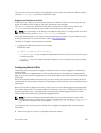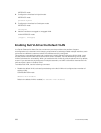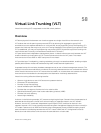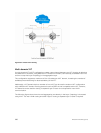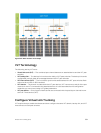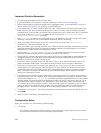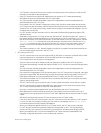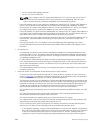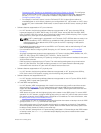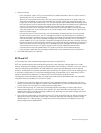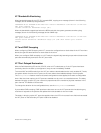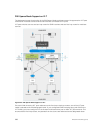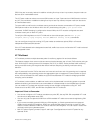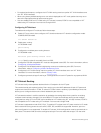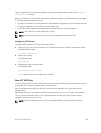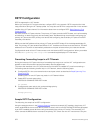
Connecting a VLT Domain to an Attached Access Device (Switch or Server)). To configure a
port in Hybrid mode so that it can carry untagged, single-tagged, and double-tagged traffic,
use the portmode hybrid command in Interface Configuration mode as described in
Configuring Native VLANs.
* For example, if the DHCP server is on the ToR and VLTi (ICL) is down (due to either an
unavailable peer or a link failure), whether you configured the VLT LAG as static or LACP, when
a single VLT peer is rebooted in BMP mode, it cannot reach the DHCP server, resulting in BMP
failure.
• Software features supported on VLT port-channels
– In a VLT domain, the following software features are supported on VLT port-channels: 802.1p,
ingress and egress ACLs, BGP, DHCP relay, IS-IS, OSPF, active-active PIM-SM, PIM-SSM, VRRP,
Layer 3 VLANs, LLDP, flow control, port monitoring, jumbo frames, IGMP snooping, sFlow, ingress
and egress ACLs, and Layer 2 control protocols RSTP only).
NOTE: PVST+ passthrough is supported in a VLT domain. PVST+ BPDUs does not result in an
interface shutdown. PVST+ BPDUs for a nondefault VLAN is flooded out as any other L2
multicast packet. On a default VLAN, RTSP is part of the PVST+ topology in that specific
VLAN (default VLAN).
– For detailed information about how to use VRRP in a VLT domain, refer to the following VLT and
VRRP Interoperability section.
– For information about configuring IGMP Snooping in a VLT domain, refer to VLT and IGMP
Snooping.
– All system management protocols are supported on VLT ports, including SNMP, RMON, AAA, ACL,
DNS, FTP, SSH, Syslog, NTP, RADIUS, SCP, TACACS+, Telnet, and LLDP.
– Enable Layer 3 VLAN connectivity VLT peers by configuring a VLAN network interface for the same
VLAN on both switches.
– IGMP snooping is supported over VLT ports. The multicast forwarding state is synchronized on
both VLT peer switches. The IGMP snooping process on a VLT peer shares the learned group
information with the other VLT peer over the chassis interconnect trunk.
• Software features supported on VLT physical ports
– In a VLT domain, the following software features are supported on VLT physical ports: 802.1p,
LLDP, flow control, IPv6 dynamic routing, port monitoring, and jumbo frames.
• Software features not supported with VLT
– In a VLT domain, the following software features are supported on non-VLT ports: 802.1x, DHCP
snooping, FRRP, ingress and egress QOS.
• VLT and VRRP interoperability
– In a VLT domain, VRRP interoperates with virtual link trunks that carry traffic to and from access
devices (refer to Overview). The VLT peers belong to the same VRRP group and are assigned
master and backup roles. Each peer actively forwards L3 traffic, reducing the traffic flow over the
VLT interconnect.
– VRRP elects the router with the highest priority as the master in the VRRP group. To ensure VRRP
operation in a VLT domain, configure VRRP group priority on each VLT peer so that a peer is either
the master or backup for all VRRP groups configured on its interfaces. For more information, refer
to Setting VRRP Group (Virtual Router) Priority.
– To verify that a VLT peer is consistently configured for either the master or backup role in all VRRP
groups, use the show vrrp command on each peer.
– Also configure the same L3 routing (static and dynamic) on each peer so that the L3 reachability
and routing tables are identical on both VLT peers. Both the VRRP master and backup peers must
be able to locally forward L3 traffic in the same way.
– In a VLT domain, although both VLT peers actively participate in L3 forwarding as the VRRP master
or backup router, the show vrrp command output displays one peer as master and the other
peer as backup.
Virtual Link Trunking (VLT)
965



